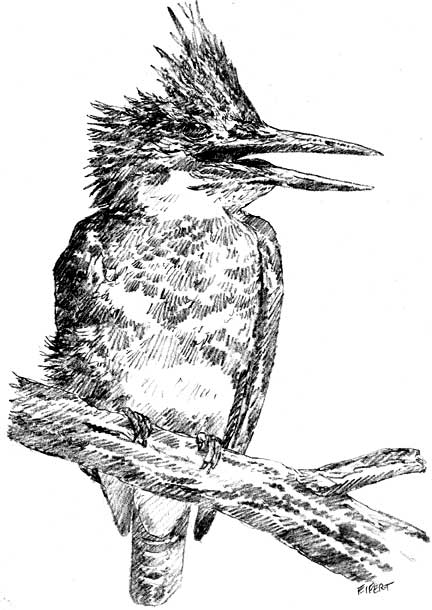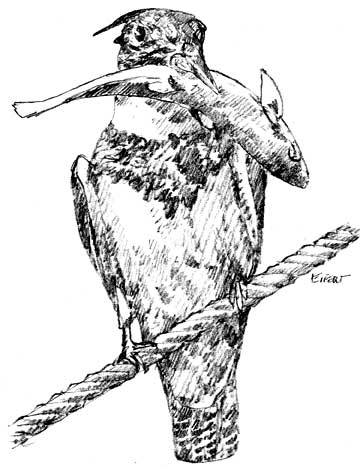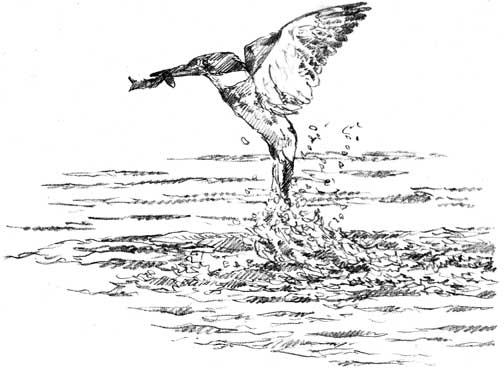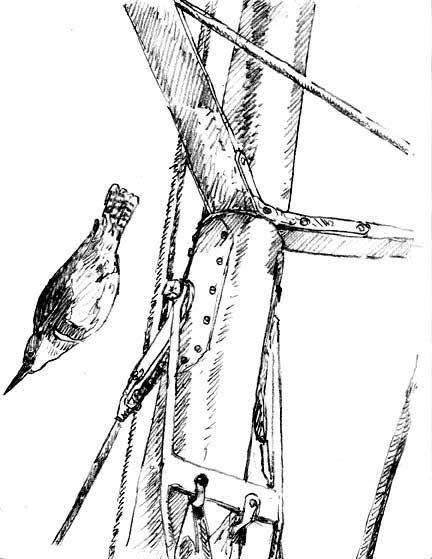| Story and illustrations by Larry Eifert
First published in 48 North magazine, May 2009 Bad Hair Day: We might pay big money for a hair cut like this – kingfishers just come this way. Varnish Day! Sounds like something important, like Election Day, but that’s just the day I’d picked for an afternoon bout of keepin’ the ol’ boat goin’. Old wooden boats are not unlike a good partner in life; they need attention occasionally. I kept a careful log last year and it worked out that the dreaded m-word (maintenance) was in play about 12% of the total time I spent aboard Sea Witch. Not that I mind it in the least, because it’s always a pure joy to make something of quality shiny again. So, there I was. The block sander had made its rounds; the vacuum had cleaned up the mess, followed by the tack rag. I was ready to uncork the can of varnish that, since the Bush Years, had become a little tin of liquid gold when overhead I heard that unmistakable chattering sound. “Yack, yack, yack, yack” – my lady-friend the slate-blue kingfisher. This noisy little bird had spent the winter here in the marina, dodging rigging during her flights up and down the fairways, fishing along with those flashy hooded mergansers that also spent time here fishing. I’d grown accustomed to her, a little flash of gray, white and chestnut that often landed on the upper spreaders of Sea Witch to eat her fishy meal. Yah, there was occasionally a bit of a mess on the desk, but to me this bird represented ‘the quality of life” and fish parts were a small penalty. The varnishing could wait a few minutes. Watching a kingfisher at close range was better. I sat back and studied her. I knew this one was a female. In most bird species, the male is the most colorful – fitting clothes for the obviously less intelligent of the genders, but kingfishers are reversed. Both have complex grayish-blue and white patterns, but the female has a reddish-chestnut band across the stomach. Catch of the Day: “It just somehow didn’t look this big when I dove.” Without teeth, kingfishers have to swallow their pray whole – or, at least try to! Belted Kingfishers are around the waters of western Washington and coastal B.C. year-round. During breeding season in spring they can get very vocal and spend their time defending local fishing territories against others of their kind. About a foot long, they have evolved a very specialized set of tools suited for their lifestyle. Their method of making a living is simple. They sit on a perch overhanging water, like a tree branch, piling or boat rigging, and when their fantastic eyesight spots a tiny three-inch fish below the water’s surface – they go for it like a rocket. A terrific plunge at lightning speed either spears the quarry or the bird manages to grab the fish in its bill. Another variation is to stop in passing flight, hover for a moment and then take the high dive. Once the fish is captured, the fisher-king finds a perch where it beats the heck out of the fish until it’s subdued, followed by rearranging it so it can be swallowed whole – gills, scales and fins pointing aft. When fish aren’t available, frogs and aquatic insects are second choice on the menu, but it’s the fish that give this skillful bird its name (afterall, they’re not the frogfisher or insectfisher). In the 1936 book, Birds of America, George Gladden wrote: “This is one of the pronounced and picturesque personalities of the feathered world – a handsome, sturdy and self-reliant bird who makes his living by the persistent, skillful and largely harmless practice of an ancient and respected art. [Fishing!] What wonderful eyesight he must have. From a fluttering halt in his flight ten or fifteen feet above the surface of the water he makes his plunge, like a blue meteor, or not infrequently from a perch fifty feet or more from the water, striking it with an impact that, one would think, would completely knock the wind out of him. It is as graceful and daring a ‘high dive’ as is to be seen anywhere”. Caught a fish and taking off: Kingfishers have to find a perch to eat their meal. Without hands, they toss their prey in the air, then catch it orientated headfirst so they can swallow it. The bill: an amazingly long and oversized appendage with a slight crook in the upper mandible, evolved so added pressure can be applied like a meat sheers or pliers. The overly-large head (like a doll) fits the bill but seemingly not the rest of the body. Feet: so small they look ludicrous. Evidently kingfishers can barely walk – but then they don’t really need to. Perching is what they’re all about, so they only need feet to grab the branch. After fifty years of watching kingfishers, I don’t ever remember seeing one walk, but they do walk. Kingfishers nest in holes in waterside banks, like so many eroded shoreline cliffs we have around the Northwest. They dig an upwards sloping tunnel sometimes eight feet deep into these sandy banks and then widen the far end for the nesting chamber. You can tell kingfisher nest holes by the “W” shaped entry. As they land, both feet scrape a slight trench on the bottom of the landing strip, and then they walk up the tunnel in total darkness to the nest. Inside, five to seven nestlings wait expectantly for their parent’s return – and a regurgitated meal. After three weeks, the fledglings work their way to the tunnel entrance and their first flight – sometimes from a hole 30 feet up on a cliff. Remember, in the confining tunnel there’s no fluttering around learning to fly for a kingfisher, and also remember, they’ve been in that black hole for weeks and not watching their parents avian skills. They simply jump and hopefully ancient instincts help them get it right during the first second. Kingfisher taking off from spreaders: From the upper spreaders of Sea Witch, the little kingfisher didn’t hesitate. With a fish locked into its excellent vision, it plunged like a meteor straight for the water. How beloved are these birds? Well, Canada has paper money with former Prime Ministers, the Queen, and – a five dollar bill with a kingfisher. It’s even kingfisher-blue. And the varnishing? It appeared the day was over! ***previous*** — ***next*** |



